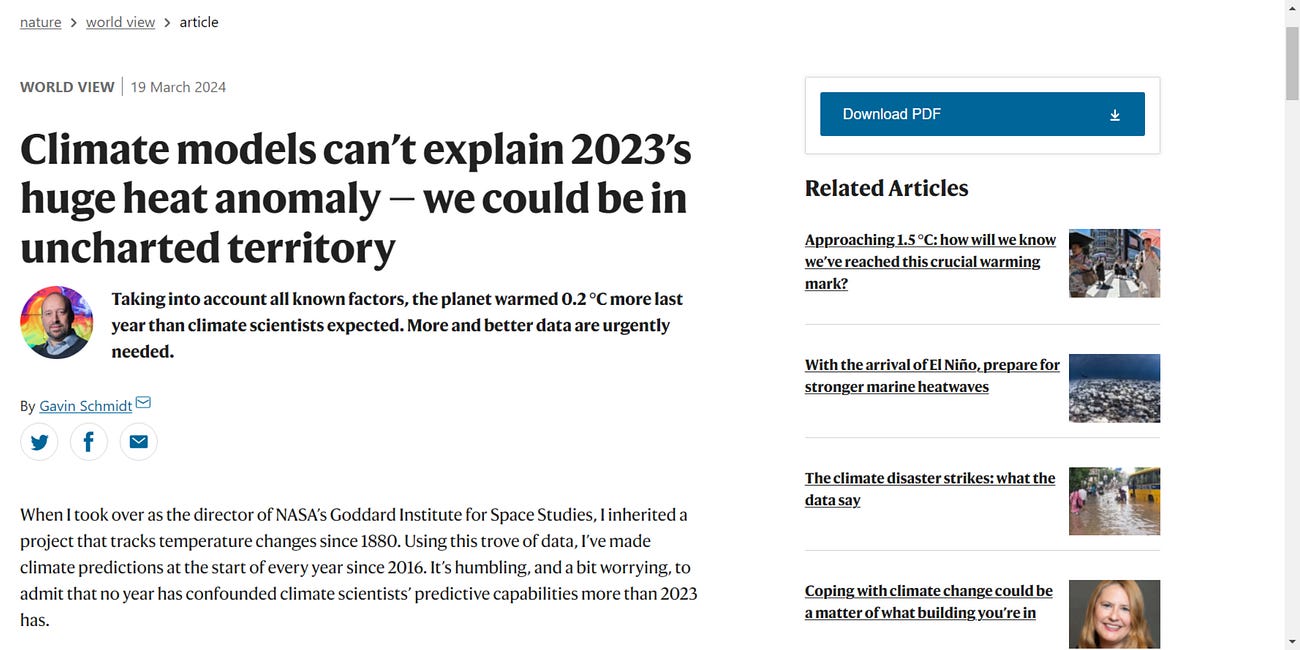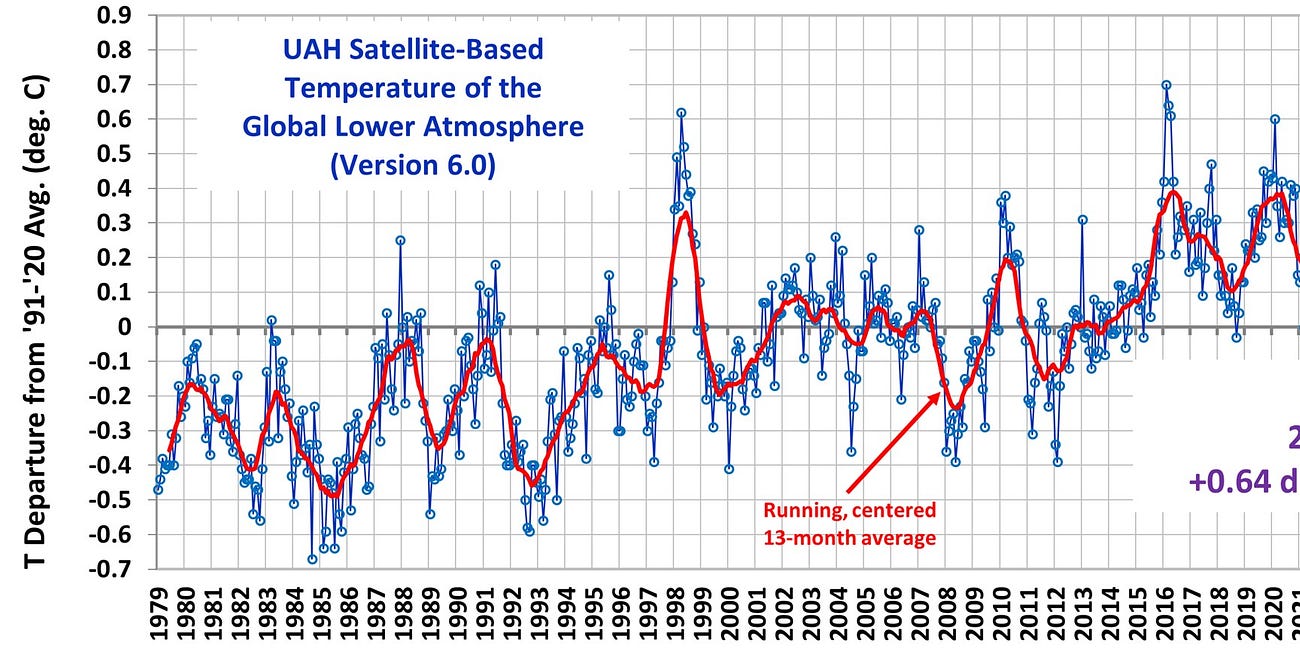Eagle eyed readers may have spotted that I made an error in my post here:
Gavin Schmidt Admits He Hasn't Got A Clue Why 2023 Was So Warm But He Now Rules Out Hunga Tonga
NASA climate scientist Gavin Schmidt has just published an article in Nature: For the past nine months, mean land and sea surface temperatures have overshot previous records each month by up to 0.2 °C — a huge margin at the planetary scale. A general warming trend is expected because of rising greenhouse-gas emissions, but this sudden heat spike greatly …
I said:
As I said at the time, the claim by Schoeberl et al 2023 is suspect because it models an equilibrium response after a quadrupling of atmospheric CO2. The HTHH eruption was clearly a very different non equilibrium event:
I was in fact confusing Schoeberl et al 2023 with this study by Wang & Huang in 2020, where they modelled the equilibrium response to stratospheric water vapour due to a long term quadrupling of CO2. My excuse is that both papers include Wang as an author and I’m sticking to it!
Schoeberl et al base their claim of ‘a few hundredths of a degree’ on something totally different. They basically sum up the instantaneous (non equilibrium) radiative forcings of aerosols and stratospheric water vapour and find that the aerosol forcing (cooling) more than compensates for the stratospheric water vapour warming:
The Hunga-Tonga-Hunga Ha'apai (HT) eruption produced increased stratospheric water vapor and aerosols primarily in the Southern Hemisphere. Jenkins et al. (2023) suggested that the increased stratospheric water vapor would warm the climate slightly, but their study neglected the role of volcanic aerosols in reducing the solar flux. We use a radiative transfer model to estimate the changes in downward IR flux due to the MLS observed enhanced water vapor layer, and OMPS-LP data to compute the stratospheric AOD. We parameterize the reduction in solar flux due to HT aerosols using past volcanic events (Table 1). Our results are nearly identical to Yu and Huang (2023) results for clear skies, non-volcanic conditions. We subsequently use their clear and all sky parameterizations to assess the direct solar forcing. The solar flux reduction by aerosols is larger than the net IR flux increase due to stratospheric water vapor. In other words, the direct solar radiative cooling associated with the HT aerosols overwhelms the enhanced thermal radiation from stratospheric water vapor plume. Our results are in good agreement with net radiative forcing changes estimated by Sellitto et al. (2022) and Zhu et al. (2022). We find that the zonal mean peak change in net radiative forcing occurs in May 2022, but the SH average forcing peaks in June/July as the constituents spread throughout the SH. Using the observed impact on tropospheric temperatures from Pinatubo as a scale, Hunga-Tonga would produce an SH annual average surface temperature change of less than −0.038°C for clear skies and −0.021°C for all skies.
This is interesting because I suggested at the beginning of August 2023 that the reason we hadn’t seen rapid warming immediately following the explosion was that the significant amounts of aerosols were having a cooling effect. These aerosols would have been flushed out of the atmosphere fairly rapidly (by summer 2023), but the water vapour would have remained (as confirmed by another scientific study); thus the sudden uptick in warming. It’s just a theory of course, but one which is lent credibility by observations and by the work of Schoeberl et al.
So here’s my suggestion: we are beginning to see rapid warming now, in summer 2023, because the radiative warming effect of the water vapour is no longer being cancelled by the aerosol cooling effect of Tonga. It’s as simple as that. On that basis, we can expect further warming over the next year or two and, with the possibility of a moderate El Nino developing in the central Pacific, that will add to the warming by the end of this year and we may be seeing a very significant rise in global temperature which of course the climate propagandists will attribute to anthropogenic greenhouse gases, so be warned; there could be much hysteria ahead, even the global declaration of a ‘climate emergency’.
Satellite Data Confirms July 2023 Was An Exceptionally Warm Month - Plus More On Why Tonga May Be The Cause
Dr Roy Spencer has updated the UAH lower tropospheric temperature series. The global temperature anomaly shot up to +0.64C in July: It’s almost as warm as February 2016 and just slightly warmer than April 1998, which marked the global warming peaks associated with two very powerful El Ninos. El Nino has barely got going at the present time so it can’t be…
If this is the case, then the 2023 warming spike will begin to reverse as soon as the more persistent stratospheric water vapour due to Hunga Tonga is itself removed from the atmosphere. At present, I am unaware of exactly how rapidly or slowly this will happen, and when it will happen - watch this space.




Good Lord! You do realise that in the world of climate “science” you’re never supposed to admit an error in your analysis - just double down and shout at anyone who has the temerity to argue!
Your thesis has some support on Judith Curry’s blog which was covered in the Daily Sceptic today.
https://judithcurry.com/2024/03/24/the-extraordinary-climate-events-of-2022-24/
https://dailysceptic.org/2024/03/26/hunga-tonga-volcano-cause-of-recent-high-temperatures-says-scientist/